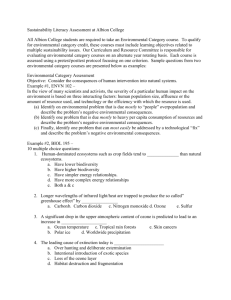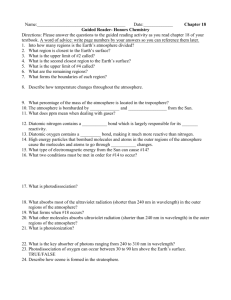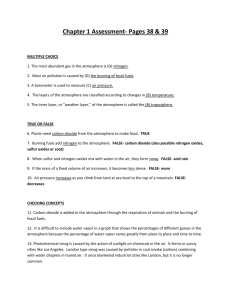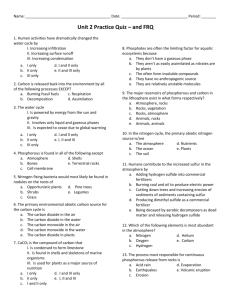Ch 18 The Atmosphere and Ch 19 environmental
advertisement
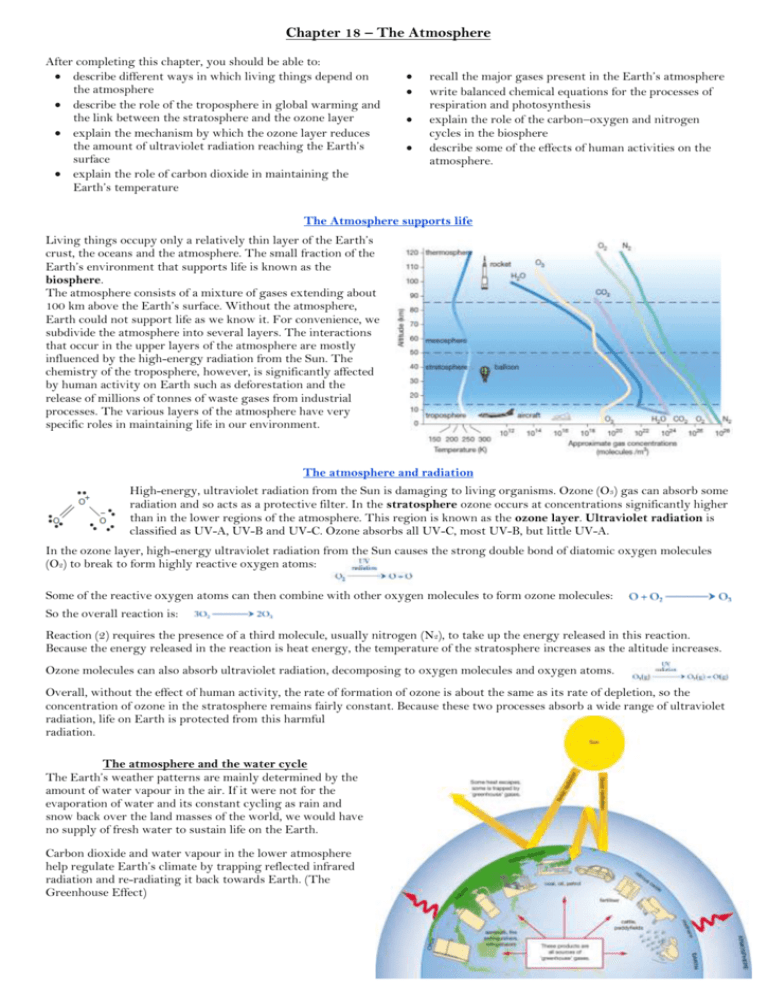
Chapter 18 – The Atmosphere After completing this chapter, you should be able to: describe different ways in which living things depend on the atmosphere describe the role of the troposphere in global warming and the link between the stratosphere and the ozone layer explain the mechanism by which the ozone layer reduces the amount of ultraviolet radiation reaching the Earth’s surface explain the role of carbon dioxide in maintaining the Earth’s temperature recall the major gases present in the Earth’s atmosphere write balanced chemical equations for the processes of respiration and photosynthesis explain the role of the carbon–oxygen and nitrogen cycles in the biosphere describe some of the effects of human activities on the atmosphere. The Atmosphere supports life Living things occupy only a relatively thin layer of the Earth’s crust, the oceans and the atmosphere. The small fraction of the Earth’s environment that supports life is known as the biosphere. The atmosphere consists of a mixture of gases extending about 100 km above the Earth’s surface. Without the atmosphere, Earth could not support life as we know it. For convenience, we subdivide the atmosphere into several layers. The interactions that occur in the upper layers of the atmosphere are mostly influenced by the high-energy radiation from the Sun. The chemistry of the troposphere, however, is significantly affected by human activity on Earth such as deforestation and the release of millions of tonnes of waste gases from industrial processes. The various layers of the atmosphere have very specific roles in maintaining life in our environment. The atmosphere and radiation High-energy, ultraviolet radiation from the Sun is damaging to living organisms. Ozone (O3) gas can absorb some radiation and so acts as a protective filter. In the stratosphere ozone occurs at concentrations significantly higher than in the lower regions of the atmosphere. This region is known as the ozone layer. Ultraviolet radiation is classified as UV-A, UV-B and UV-C. Ozone absorbs all UV-C, most UV-B, but little UV-A. In the ozone layer, high-energy ultraviolet radiation from the Sun causes the strong double bond of diatomic oxygen molecules (O2) to break to form highly reactive oxygen atoms: Some of the reactive oxygen atoms can then combine with other oxygen molecules to form ozone molecules: So the overall reaction is: Reaction (2) requires the presence of a third molecule, usually nitrogen (N2), to take up the energy released in this reaction. Because the energy released in the reaction is heat energy, the temperature of the stratosphere increases as the altitude increases. Ozone molecules can also absorb ultraviolet radiation, decomposing to oxygen molecules and oxygen atoms. Overall, without the effect of human activity, the rate of formation of ozone is about the same as its rate of depletion, so the concentration of ozone in the stratosphere remains fairly constant. Because these two processes absorb a wide range of ultraviolet radiation, life on Earth is protected from this harmful radiation. The atmosphere and the water cycle The Earth’s weather patterns are mainly determined by the amount of water vapour in the air. If it were not for the evaporation of water and its constant cycling as rain and snow back over the land masses of the world, we would have no supply of fresh water to sustain life on the Earth. Carbon dioxide and water vapour in the lower atmosphere help regulate Earth’s climate by trapping reflected infrared radiation and re-radiating it back towards Earth. (The Greenhouse Effect) The atmosphere and the essential gases Nitrogen and oxygen are the two most abundant gases in the atmosphere, making up about 99% of clean dry air at sea. Both of these, as well as the much less abundant carbon dioxide, are essential in maintaining life on Earth. Oxygen and Carbon dioxide Oxygen, which makes up almost 21% of the atmosphere, is required for respiration in plants and animals. In respiration, glucose reacts with oxygen to produce carbon dioxide and water. Respiration is the major energy producing process of most living things: Carbon dioxide makes up only 0.035%, by volume, of the atmosphere. However, this small amount provides, either directly or indirectly, all food used by plants and animals. In photosynthesis, plants combine carbon dioxide and water, in the presence of the green pigment chlorophyll and sunlight, to produce glucose and oxygen. These green plants are the bottom of the food chain for most animals. Through the processes of photosynthesis and respiration, both oxygen and carbon dioxide are cycled in nature. This process is called the carbon– oxygen cycle. Photosynthesis in plants is the most significant process that consumes carbon dioxide, which is then released into the atmosphere during respiration in plants and animals. The cycling of both oxygen and carbon dioxide in the processes of photosynthesis and respiration is quite rapid. Carbon dioxide is also returned to the atmosphere when an organism’s wastes are decomposed or when it dies. This is a much slower recycling process. Other processes that contribute to the carbon–oxygen cycle include: volcanic action and the combustion of fossil fuels, which add carbon dioxide to the atmosphere the slow production of coal, oil and natural gas over a period of several million years from the remains of dead organisms The formation of calcium carbonate from dead coral and the skeletons of marine animals in the sea. This process removes carbon from the cycle. The amount of carbon present at any particular stage of this cycle depends on the rate at which it enters and leaves that stage. At present, atmospheric carbon dioxide levels are increasing due to various factors including the rapid rate at which we are burning fossil fuels. Nitrogen All living creatures need a source of nitrogen in order to produce essential large biomolecules such as proteins and DNA. Although about 78% of the atmosphere is made up of nitrogen gas, most living things cannot use it in this form. Life on this planet depends upon the activities of a few species of microorganisms that can break the strong triple covalent bond within the nitrogen molecule to form simple nitrogen-containing ions such as ammonium (NH +) or nitrate (NO ) ions. These can then be used by plants to make more complex nitrogen-containing molecules. Animals must rely on these complex nitrogen-containing compounds in plants as their nitrogen source. The conversion of atmospheric nitrogen into soluble nitrogen compounds that can be used by plants is called nitrogen fixation. 4 3 - Although insufficient for biological needs, a small amount of natural nitrogen fixation occurs when lightning discharges convert nitrogen gas to nitrogen(II) oxide gas (NO). Nitrogen(II) oxide is also released by volcanic action and is present in industrial and automobile emissions. It reacts with oxygen to form nitrogen(IV) oxide gas: Nitrogen dioxide reacts with rain water to form a mixture of nitrous acid (HNO2) and nitric acid (HNO3): The rain becomes a mildly acidic fertiliser. Nitrogen is returned to the atmosphere when bacteria and other organisms in the soil cause organic matter to decay. Unlike carbon dioxide, the amount of atmospheric nitrogen is thought to be fairly stable. However, other stages of the nitrogen cycle have been significantly affected by industrial and agricultural activities. For example, levels of atmospheric nitrogen oxides have risen due to industrial emissions. Human Activities and the Atmosphere The rate of change in the composition of the atmosphere has increased dramatically in the past 200 years as a result of human activity. Contributing factors include: clearing of forests to make way for agriculture and so reducing the amount of carbon dioxide uptake by photosynthesis burning of coal to produce electricity, which converts sulfur in coal to sulfur dioxide, which is released into the atmosphere using fossil fuels in transport, which results in significant emissions of carbon and nitrogen oxides and unburnt hydrocarbons using propellants in aerosols and foaming agents, which interfere with the balance of atmospheric gases. Chapter 18 Questions: Q1, 5, 6, 7, 12, 13, 14, 15, 17 Chapter 19 – Environmental Issues (Part 1) After completing this chapter, you should be able to: explain why non-polluted rain has a pH less than 7 identify the sources of oxides of sulfur and nitrogen in the atmosphere write equations for the reactions that lead to the formation of acid rain identify some of the effects of acid rain suggest some means by which acid rain can be minimised explain how compounds such as CFCs contribute to the depletion of the ozone layer describe the environmental effect of ozone depletion in the stratosphere List the waste products of the internal combustion engine identify the primary pollutants that lead to the formation of photochemical smog list some of the secondary pollutants that make up photochemical smog explain the condition of temperature inversion state some of the environmental consequences of photochemical smog explain what is meant by the enhanced greenhouse effect list the more significant greenhouse gases discuss the consequences of global warming give some examples of the protocols designed to reduce greenhouse emissions. Acid Rain Natural rainfall is normally slightly acidic because water dissolves carbon dioxide from the air to produce carbonic acid (H 2CO3). During the last 20 years, many countries, particularly in Europe and North America, have been experiencing rain that is more acidic than normal. This is known as acid rain. Formation of Acid Rain - Acid rain occurs when acidic oxides of sulfur and nitrogen dissolve in rain water to form acids. Most of the oxides of sulfur present in the atmosphere are the result of natural processes such as volcanic eruptions or biological decay. It is the sulfur oxides produced by human activity that cause environmental problems because of their high concentration over relatively small areas, mainly large cities. Sulfur is present in plants and so sulfur is also found in fossil fuels. When fuels are burnt, sulfur dioxide gas is produced. Industrially, the majority of sulfur oxides emissions are due to the burning of fossil fuels, particularly coal. The extraction of metals, such as copper, from their sulfide ores also contributes to sulfur dioxide emissions: In the presence of sunlight, sulfur dioxide is further oxidised to sulfurtrioxide: These gases react readily with rain water to form sulfurous acid and sulfuric acid. Oxides of nitrogen (NO and NO2) are collectively known as NOx. They are formed naturally from volcanoes, lightning flashes and bacterial action in the soil. However, like the oxides of sulfur, it is those produced by human activity and concentrated over relatively small areas that lead to environmental problems. Nitrogen(II) oxide (NO) forms whenever nitrogen and oxygen are mixed at extremely high temperatures. High temperatures are generated in internal combustion and jet engines. This is the main source of NO although some is also produced in power plants and the burning of fuels in industry. So, at high temperatures: At lower temperatures, when released into the atmosphere, NO reacts readily with oxygen to form the brown poisonous gas nitrogen(IV) oxide (NO2): NO2 is an acidic oxide that dissolves readily in rain water to form a mixture of nitrous acid and nitric acid: Effects of Acid Rain Acid rain has a detrimental effect on the environment. Building materials made of marble or limestone (mostly calcium carbonate), react with acid rain, causing them to slowly wear away: CaSO4(s) is slightly water soluble and some of it will wash away. The CaSO4 that remains is bulky and changes the appearance of the stonework. Acid rain also increases the rate of corrosion of steel structures. Acid rain increases soil acidity and stunts plant growth. Low pH causes some essential minerals such as Mg2to leach from the soil. Without Mg2, plants cannot photosynthesise. In waterways, aquatic life is particularly sensitive to increased levels of acidity. Even a slight decrease in pH prevents some fish from breeding. Acid rain has a pH of 5.5 or less and it has been blamed for the destruction of vast forest areas and the decimation of fish populations, particularly in Europe and North America. In humans, acid rain has been linked to irritation of mucous membranes and to respiratory illness, particularly in the old and very young. Efforts to reduce the effects of acid rain include: using low-sulfur fuels removing sulfur from coal before combustion removing SO2 from flue gases of power plants improving the design of combustion engines to reduce NOx emissions. However, acid rain will continue to cause problems until all countries accept their responsibility and limit their own emissions. Although you, as an individual, might believe that the cost to society of using fossil fuels outweighs their benefits, you would find it difficult to avoid using them without making considerable changes to your way of life. For example, you cannot buy a solarpowered television set. Therefore, if you wanted to watch television you would be obliged to use electricity that has probably been generated from coal. Feasible alternatives to fossil fuels are not easy to find. Depletion of the Ozone layer As discussed in Chapter 18, the ozone layer, most of it within a band 10–30 km above the Earth’s surface, protects life on Earth by absorbing ultraviolet (UV) radiation. UV radiation causes skin cancer and cataracts and suppresses the immune system in humans. Exposure can damage plant life and aquatic ecosystems. Scientists first became concerned about possible damage to the ozone layer in 1971, with proposals to develop supersonic aircraft, which would fly at extremely high altitudes. It was suggested that the jet engines of these aircraft would produce nitrogen oxide (NO) from the reaction between the nitrogen and oxygen in the air drawn into the engines. The nitrogen(II) oxide produced in this reaction in the stratosphere could then act as a catalyst to break down ozone. The net effect of these reactions is: The nitrogen(II) oxide is then free for further reactions with ozone. There is now widespread concern that other gases produced by human activities have damaged the ozone layer. These gases are chlorofluorocarbons (CFCs) and halons. Halons are thought to cause more damage to the ozone layer than chlorofluorocarbons. Although these compounds are not produced widely now, it will be many years before their effect on the ozone layer decreases significantly. CFCs are long lived because they are unreactive in the lower atmosphere. In regions near the Earth’s surface they are virtually inert. Eventually they move up into the stratosphere, where they can be broken down by ultraviolet light, releasing free halogen atoms, such as chlorine. These atoms have a destructive effect on ozone similar to that of nitrogen oxide.

